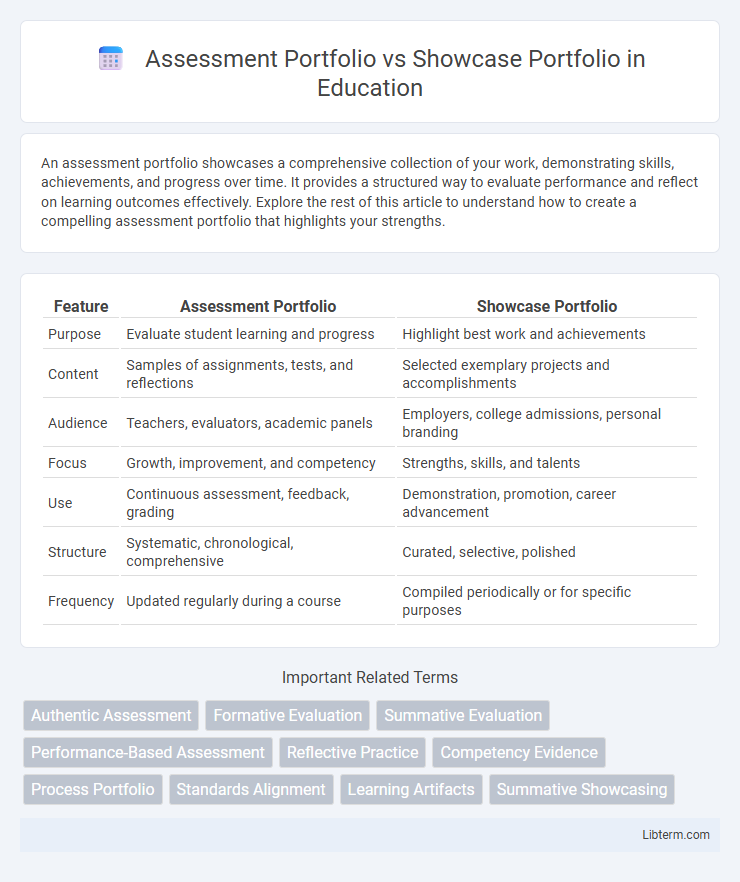An assessment portfolio showcases a comprehensive collection of your work, demonstrating skills, achievements, and progress over time. It provides a structured way to evaluate performance and reflect on learning outcomes effectively. Explore the rest of this article to understand how to create a compelling assessment portfolio that highlights your strengths.
Table of Comparison
| Feature | Assessment Portfolio | Showcase Portfolio |
|---|---|---|
| Purpose | Evaluate student learning and progress | Highlight best work and achievements |
| Content | Samples of assignments, tests, and reflections | Selected exemplary projects and accomplishments |
| Audience | Teachers, evaluators, academic panels | Employers, college admissions, personal branding |
| Focus | Growth, improvement, and competency | Strengths, skills, and talents |
| Use | Continuous assessment, feedback, grading | Demonstration, promotion, career advancement |
| Structure | Systematic, chronological, comprehensive | Curated, selective, polished |
| Frequency | Updated regularly during a course | Compiled periodically or for specific purposes |
Understanding Assessment Portfolios
Assessment portfolios systematically collect evidence of student learning, skills, and progress over time to evaluate achievement against specific criteria and learning objectives. They emphasize reflection, self-assessment, and teacher feedback, providing a comprehensive view of development and areas for improvement. This type of portfolio supports formative and summative assessment practices, ensuring alignment with educational standards and enhancing personalized learning outcomes.
Defining Showcase Portfolios
Showcase portfolios highlight an individual's best work, emphasizing creativity, skill, and personal achievements to attract employers or clients. They differ from assessment portfolios by focusing more on presentation and impact rather than evaluation criteria or academic performance. Designed to impress, showcase portfolios often include well-curated samples that demonstrate expertise and unique style.
Key Purposes: Assessment vs. Showcase
Assessment portfolios primarily serve to evaluate a learner's progress and competencies through systematic documentation of skills and achievements, often aligned with educational standards. Showcase portfolios highlight an individual's best work to demonstrate talents and creativity, aimed at impressing potential employers or clients. The key purpose distinguishes assessment portfolios as tools for measurement, while showcase portfolios function as marketing and personal branding instruments.
Content Selection Criteria
Assessment portfolios require content aligned with specific learning objectives and performance criteria to demonstrate measurable progress and competency. Showcase portfolios prioritize selecting diverse, high-quality samples that highlight creativity, skills, and personal achievements to impress potential employers or clients. Content selection in assessment portfolios focuses on evidence of growth and mastery, whereas showcase portfolios emphasize versatility and standout work.
Evaluation and Feedback Methods
Assessment portfolios emphasize systematic evaluation through standardized rubrics and criteria designed to measure specific learning outcomes, facilitating structured feedback that targets skill development and mastery. Showcase portfolios prioritize qualitative feedback, highlighting strengths and accomplishments with reflective commentary to support personal growth and self-assessment. Evaluation methods in assessment portfolios are often formal and summative, while showcase portfolios favor informal, formative feedback encouraging continuous improvement and motivation.
Audience Differences
Assessment portfolios primarily target educators and evaluators seeking comprehensive evidence of a learner's progress, skills, and competencies over time. Showcase portfolios are designed for potential employers, clients, or admissions committees, emphasizing the individual's best work and achievements to highlight strengths and talents. Audience expectations drive the content selection, with assessment portfolios focusing on breadth and growth, while showcase portfolios prioritize impact and presentation quality.
Benefits of Assessment Portfolios
Assessment portfolios offer a structured approach to evaluating a learner's progress through documented evidence of skills, projects, and reflections, fostering deeper self-awareness and targeted feedback. They enable educators to track developmental milestones and competency mastery, supporting personalized learning pathways and data-driven decision-making. The systematic organization of assessment portfolios enhances accountability and provides a comprehensive record for academic or professional evaluation purposes.
Advantages of Showcase Portfolios
Showcase portfolios highlight an individual's best work, effectively demonstrating skills and achievements to potential employers or clients. They enhance personal branding by presenting a curated selection that emphasizes quality over quantity, making a strong visual impact. Employers benefit from quickly assessing the candidate's strengths and creativity through well-organized and compelling presentations.
Choosing the Right Portfolio for Your Needs
Choosing the right portfolio depends on your goals: an assessment portfolio emphasizes demonstrating learning progress and skills through structured evidence, ideal for academic or professional evaluations. Showcase portfolios highlight your best work to impress potential employers or clients, focusing on creativity and final outcomes. Understanding whether you need to validate competencies or market your achievements will guide the selection between these two portfolio types.
Hybrid Portfolio Approaches
Hybrid portfolio approaches combine the reflective, evaluative elements of Assessment Portfolios with the curated, presentation-focused aspects of Showcase Portfolios to provide a comprehensive view of a learner's progress and achievements. These portfolios integrate formative assessments and self-reflections alongside selected work samples that highlight competencies and skills, enhancing both feedback quality and professional representation. By blending assessment data with polished artifacts, hybrid portfolios support continuous learning while effectively demonstrating growth to educators, employers, or clients.
Assessment Portfolio Infographic

 libterm.com
libterm.com